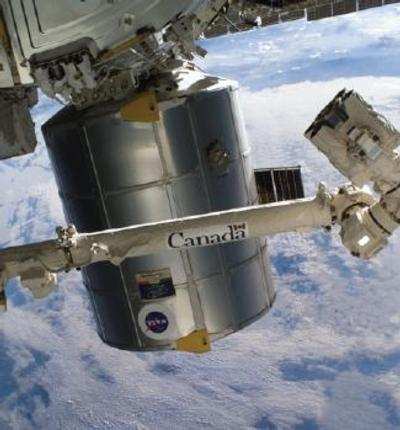Rocket's First Stage Transported To New Launch Pad To Commence Full-Scale Operations
Orbital Sciences Corporation said Monday that it has commenced Antares launch vehicle operations at the liquid-fuel launch complex at the Mid-Atlantic Regional Spaceport (MARS). Following a four-year design, development, construction, test and inspection process, the Virginia Commercial Space Flight Authority (VCSFA), which oversees MARS, has authorized Orbital to begin on-pad operations leading up to flight demonstrations of its Antares medium-class launch vehicle and Cygnus cargo logistics spacecraft. These are the vehicles Orbital will use to fulfill a $1.9 billion NASA contract to deliver essential cargo to the International Space Station (ISS). The MARS launch complex is located at NASA’s Wallops Flight Facility in eastern Virginia and is owned and operated by MARS, under the auspices of the VCSFA, which receives its funding from the Commonwealth of Virginia.

“MARS has completed construction and testing operations on its launch complex at Wallops Island, the first all-new large-scale liquid-fuel launch site to be built in the U.S. in decades,” said David W. Thompson, Orbital’s President and Chief Executive Officer. “Accordingly, our pad operations are commencing immediately in preparation for an important series of ground and flight tests of our Antares medium-class launch vehicle over the next few months. In fact, an Antares first stage test article (has been) transported to the pad from its final assembly building about a mile away, marking the beginning of full pad operations.”
Over the next several months, the company plans to complete three major program milestones, including an on-pad hot-fire test of the Antares first stage, the maiden flight of a fully operational Antares rocket, and a demonstration mission to the ISS of Orbital’s cargo delivery system, prior to commencing operational cargo delivery missions under NASA’s Commercial Resupply Services (CRS) agreement in 2013. This system, developed under the Commercial Orbital Transportation Services (COTS) joint research and development agreement with NASA, is made up of an Antares rocket, a Cygnus advanced maneuvering cargo logistics spacecraft, and ground-based mission operations command and control facilities.
The first of the three milestones, the Antares hot-fire test operation, will demonstrate the readiness of the rocket’s first stage and launch pad fueling systems to support the upcoming flights. The hot-fire test involves firing Antares’ dual AJ26 rocket engines that will generate a combined total thrust of 680,000 lbs. for approximately 30 seconds while the first stage is held down on the pad. The hot-fire operation is expected to be conducted in four to five weeks following integration and check-out of the Antares first stage test unit with the launch complex’s fueling systems.

The hot-fire test will be followed about one month later by the maiden flight of the Antares rocket, which will carry a Cygnus mass simulator payload that will be heavily instrumented to gather data on the launch environment aboard Antares. In addition, four small “pico satellites” will be deployed from two dispensers that will be integrated with the mass simulator.
The last of the three COTS test milestones will be the COTS demonstration mission to the ISS. For this mission, a fully operational Cygnus spacecraft will be launched into orbit by Antares and, following an extensive series of in-orbit tests, will autonomously rendezvous and berth with the ISS. The first Cygnus will deliver approximately 1,200 pounds of cargo upon its arrival and will remove about 2,200 pounds of disposal cargo upon its departure from the orbiting laboratory.
(Pictured: Artist's rendering of Cygnus spacecraft docked at ISS)
 Unfortunate... ANN/SportPlane Resource Guide Adds To Cautionary Advisories
Unfortunate... ANN/SportPlane Resource Guide Adds To Cautionary Advisories ANN FAQ: Turn On Post Notifications
ANN FAQ: Turn On Post Notifications ANN's Daily Aero-Term (04.29.24): Visual Approach Slope Indicator (VASI)
ANN's Daily Aero-Term (04.29.24): Visual Approach Slope Indicator (VASI) ANN's Daily Aero-Term (04.28.24): Airport Marking Aids
ANN's Daily Aero-Term (04.28.24): Airport Marking Aids ANN's Daily Aero-Linx (04.28.24)
ANN's Daily Aero-Linx (04.28.24)




